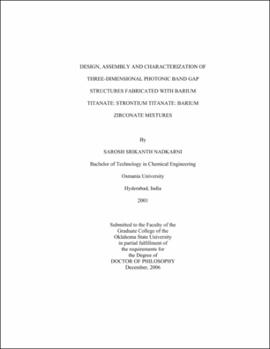| dc.contributor.advisor | Smay, James E. | |
| dc.contributor.author | Nadkarni, Sarosh Srikanth | |
| dc.date.accessioned | 2013-11-26T08:31:41Z | |
| dc.date.available | 2013-11-26T08:31:41Z | |
| dc.date.issued | 2006-12 | |
| dc.identifier.uri | https://hdl.handle.net/11244/7164 | |
| dc.description.abstract | Scope and Method of Study: Ternary mixtures of barium titanate (BT), strontium titanate (ST) and barium zirconate (BZ) were investigated as materials for three-dimensional, periodic, layer-by-layer structures used as photonic crystals. Highly concentrated aqueous based ceramic gels were formulated using colloidal processing and printed using an extrusion based direct write technique called robocasting. Bulk films with a range of molar ratios were printed and their electrical characteristics determined at low frequencies to develop composition-properties maps. Based on this data, face centered tetragonal lattices were printed with varying compositions and their frequency dependent transmission spectra determined using time domain terahertz spectroscopy. The experimentally obtained band structures were compared to those obtained by modeling using the transfer matrix method. | |
| dc.description.abstract | Findings and Conclusions: It was found that a cationic polyelectrolyte salt, poly(ethylenime) was an effective flocculant for aqueous slurries of co-dispersed barium titanate, strontium titanate, and barium zirconate ceramics powders dispersed using ammonium polyacrylate and yielded inks suitable for fabrication of fine lattice structures. After a pre-shear, gel modulus recovery was found to follow a two step recovery process. An instantaneous recovery on the order of 1-2 seconds and then a gradual recovery over a much longer period (at least 1/2 h). The gradual recovery was found to obey an exponential decay curve with the decay constant being inversely proportional to gel strength. For ternary mixtures of barium titanate: strontium titanate: barium zirconate it was discovered that compositions rich in barium titanate exhibited the highest dielectric constants, loss and tunability whereas all these properties decreased significantly as the barium titanate phase was diluted. The Curie temperature also shifted to lower temperatures as the composition became richer in [Sr2+] or [Zr4+]. A range of dielectric properties were thus obtained by mixing the three dielectrics in different molar ratios. Some mixtures were used to fabricate layer by layer photonic crystals using an extrusion based robotic deposition technique called robocasting. Transmission measurements, done using terahertz time domain spectroscopy, indicated photonic band gaps that were within 10% of the predicted results obtained by using the transfer matrix method for computation of transmission spectra. | |
| dc.format | application/pdf | |
| dc.language | en_US | |
| dc.rights | Copyright is held by the author who has granted the Oklahoma State University Library the non-exclusive right to share this material in its institutional repository. Contact Digital Library Services at lib-dls@okstate.edu or 405-744-9161 for the permission policy on the use, reproduction or distribution of this material. | |
| dc.title | Design, assembly and characterization of three-dimensional photonic band gap structures fabricated with barium titanate: strontium titanate: barium zirconate mixtures | |
| dc.contributor.committeeMember | Rhinehart, R. Russell | |
| dc.contributor.committeeMember | Gasem, Khaled | |
| dc.contributor.committeeMember | Ackerson, Bruce J. | |
| dc.contributor.committeeMember | High, Marty | |
| osu.filename | Nadkarni_okstate_0664D_2114.pdf | |
| osu.accesstype | Open Access | |
| dc.type.genre | Dissertation | |
| dc.type.material | Text | |
| thesis.degree.discipline | Chemical Engineering | |
| thesis.degree.grantor | Oklahoma State University | |
